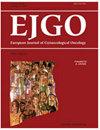盆底功能障碍对子宫内膜癌患者治疗后的影响。文献综述
IF 0.5
4区 医学
Q4 OBSTETRICS & GYNECOLOGY
引用次数: 0
摘要
子宫内膜癌(EC)幸存者正在逐渐增加。然而,治疗这种疾病可能会对盆腔器官产生不利影响,导致盆底疾病(PFD):尿失禁、盆腔器官脱垂和肠功能障碍。本综述的目的是调查手术和非手术治疗后EC幸存者中PFD的患病率。作者对以下数据库进行了结构化检索:MEDLINE、EMBASE、Global Health、Cochrane Library和Web of Science,检索时间从成立到2021年8月。纳入标准为:(1)患有EC的女性,(2)观察性研究,(3)原始数据,(4)PFD结果评估,(5)使用经过验证的PFD评估工具。最初的搜索发现了590篇关于PFD和子宫内膜癌的文章。最终只有10项研究可供进一步分析,其中包括1849名EC患者。总的来说,EC治疗后尿失禁的发生率从7.6%增加到20.8%。治疗后应激性尿失禁发生率为23% ~ 74.3%,急迫性尿失禁发生率为20.8% ~ 71.4%。638例EC幸存者中POP患病率高达13.6%。732例EC幸存者中大便失禁的发生率为21%。总之,子宫内膜癌治疗后常见PFDs。缺乏EC类型和治疗类型之间的比较研究,限制了进一步探索EC幸存者之间PFD频率的差异和EC治疗的多样性。本文章由计算机程序翻译,如有差异,请以英文原文为准。
Pelvic floor dysfunction in endometrial cancer patients after treatment. A literature review
Endometrial cancer (EC) survivors are increasing progressively. However, treating this disorder may detrimentally affect the pelvic organs, resulting in pelvic floor disorders (PFD): urinary incontinence, pelvic organ prolapse, and bowel dysfunction. The aim of this review is to investigate the prevalence of PFD in EC survivors following both surgical and nonsurgical treatments. The authors conducted a structured search in the following databases: MEDLINE, EMBASE, Global Health, The Cochrane Library, and Web of Science from inception until August 2021. The inclusion criteria were: (1) women with EC, (2) observational studies, (3) original data, (4) PFD result evaluation, and (5) the use of verified tools for the evaluation of PFD. The initial search found 590 articles for PFD and endometrial cancer. Only 10 of the studies were finally available for further analysis, including 1849 individuals with EC. In total, the incidence of UI increased from 7.6% to 20.8% after EC therapy. The incidence of stress and urge UI after treatment ranged from 23 to 74.3% and 20.8 to 71.4%, respectively. The prevalence of POP was as high as 13.6% in 638 EC survivors. The prevalence of fecal incontinence was 21% in 732 EC survivors. In conclusion, PFDs are common after endometrial cancer treatment. The lack of comparative studies between the type of EC and the type of treatment limits further exploration of the differences in PFD frequency among EC survivors and the variety of EC treatments.
求助全文
通过发布文献求助,成功后即可免费获取论文全文。
去求助
来源期刊
自引率
25.00%
发文量
58
审稿时长
1 months
期刊介绍:
EJGO is dedicated to publishing editorial articles in the Distinguished Expert Series and original research papers, case reports, letters to the Editor, book reviews, and newsletters. The Journal was founded in 1980 the second gynaecologic oncology hyperspecialization Journal in the world. Its aim is the diffusion of scientific, clinical and practical progress, and knowledge in female neoplastic diseases in an interdisciplinary approach among gynaecologists, oncologists, radiotherapists, surgeons, chemotherapists, pathologists, epidemiologists, and so on.

 求助内容:
求助内容: 应助结果提醒方式:
应助结果提醒方式:


